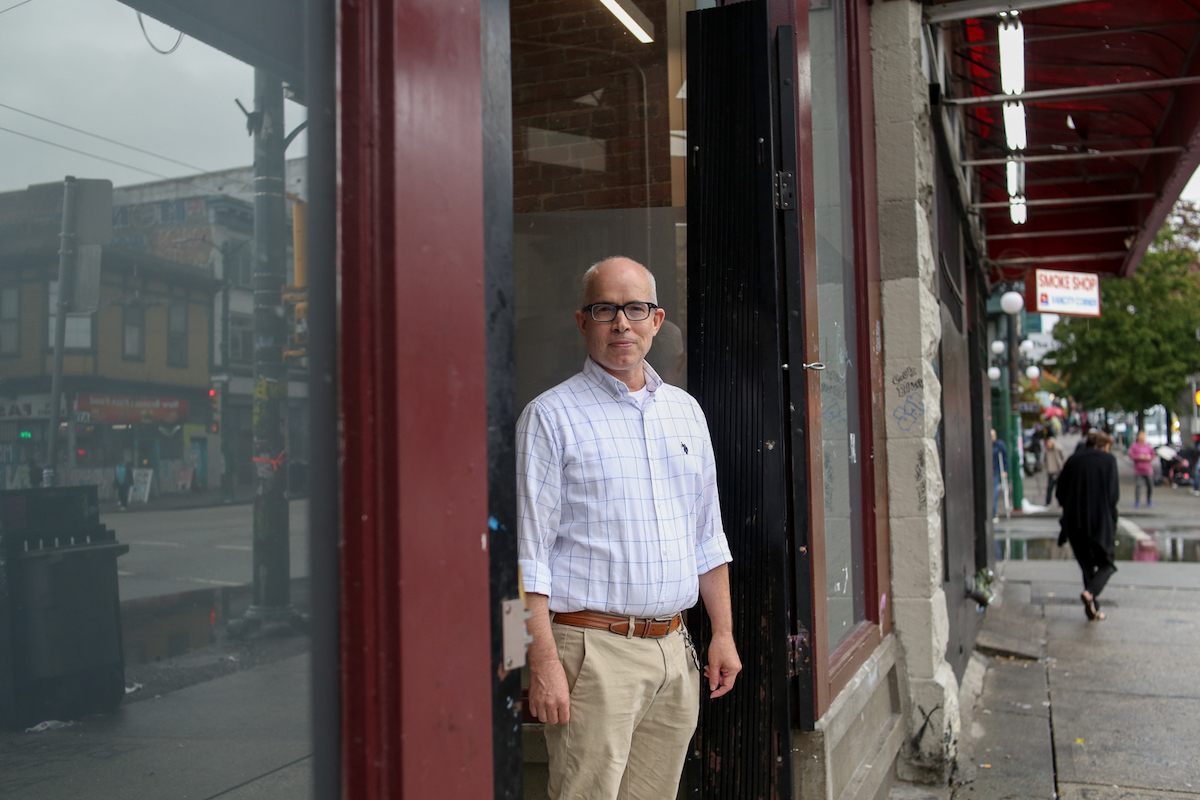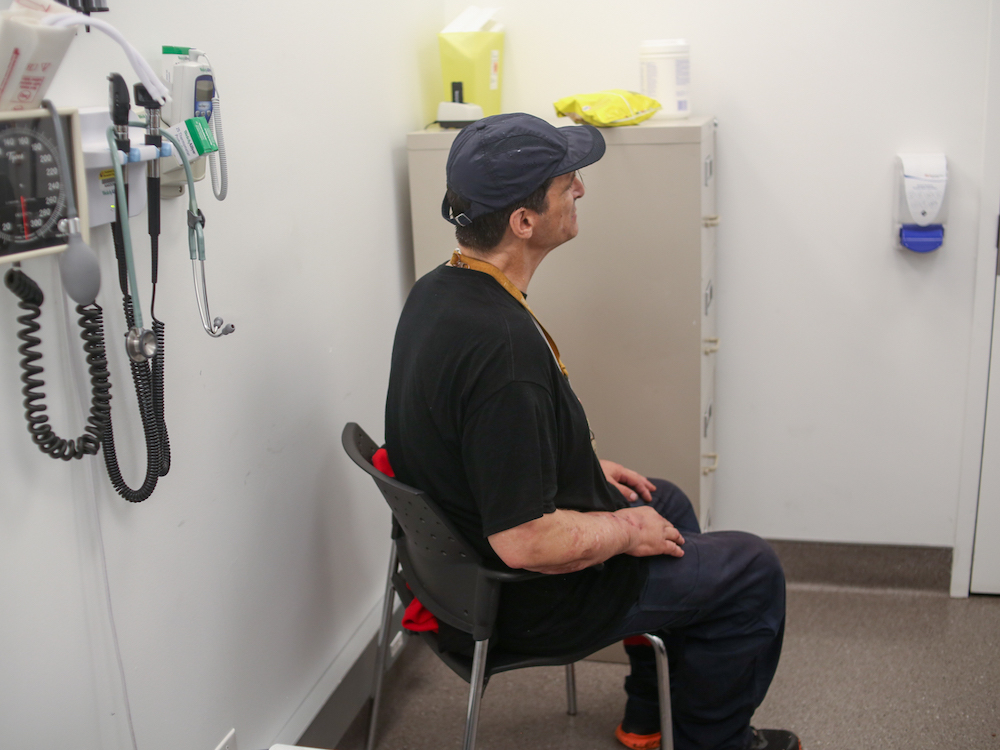Crosstown Clinic patient Michel has used opiates for 30 years. His addiction to heroin, he says, drove him to use “alternative methods to get money, like criminal activity.”
Six years ago, exhausted by the lifestyle he was leading, Michel joined Crosstown as a patient and began accessing prescription injectable heroin.
“It worked from day one,” he says. “There was immediate relief from the daily grind all addicts go through — it felt like freedom.”
Providence Health Authority’s Crosstown Clinic in Vancouver’s Downtown Eastside offers a range of treatments for opioid use disorder, including opioid agonist therapy, medical care and wraparound services with social workers and counsellors.
British Columbia first declared a public health emergency due to toxic drugs in 2016. Since then, the drug supply has only increased in potency and unpredictability, with fentanyl, carfentil and benzodiazepines — which can increase the risk of overdose and complicate the reversal of overdoses — showing up more and more frequently. Toxic drugs have killed over 12,700 British Columbians since 2016, making unregulated drug toxicity the leading cause of death in the province for people aged 10 to 59.
While the province has been ramping up harm reduction initiatives, such as distributing naloxone kits and permitting safer supply, it has not been able to keep up with the toxicity of drugs bought on the illicit market, leading to a rise in toxic drug deaths year after year.
Observed injected opioid agonist treatment is currently available daily at the Crosstown Clinic in Vancouver, as well as in the U.K., Netherlands, Denmark, Germany and Switzerland.
The British Columbia Centre on Substance Use defines opioid agonist treatment as prescription opioids that reduce opioid-related harms, reduce how often a person uses opioids sourced illicitly, and that improve their mental health, social functioning and quality of life. In B.C., OAT includes opioids taken orally, such as Suboxone (buprenorphine/naloxone), methadone (which can be sold under the names Methadose or Metaldol D), and Kadian (slow-release oral morphine).
OAT is different from safer supply, which is a harm reduction practice where clinicians prescribe pharmaceutical drugs in order to reduce a patient’s need to rely on the illicit market. Safer supply can include diacetylmorphine, Dilaudid (oral hydromorphone) and M-Eslon (sustained-release oral morphine). For people who are not interested in OAT, or who are still at high risk of overdose even while on OAT, safer supply reduces their risk of overdose, death and other harms, according to the BCCSU.
While offering patients injectable diacetylmorphine and hydromorphone is considered standard injectable opioid agonist treatment in many countries, it’s still considered an “emerging treatment” in Canada.

Safer supply has recently become a bit of a political wedge issue. Conservative Party of Canada Leader Pierre Poilievre, for example, has been critical of programs that offer pharmaceutical alternatives to street drugs, which include OAT and safer supply programs. He says federal money would be better spent on getting people into recovery.
Poilievre has also raised concerns that safer supply is being resold by patients. In a previous article, The Tyee spoke with experts who said diversion happens when the potency of safer supply doesn’t match the potency or combination of illicit drugs a person is used to taking. Diversion is not creating more overdose deaths, they added.
Meanwhile, advocates say that B.C. and Canada should be increasing access to safer supply. In June, the BC Centre for Disease Control told The Tyee that only around 5,000 patients — about five per cent of people who have been diagnosed with opioid use disorder in B.C. — have accessed safer supply so far.
Dr. Scott MacDonald, Crosstown Clinic’s lead physician, says people have complex reasons for using drugs and benefit from a variety of treatment options, including a range of medications to reduce their risk of illicit street drug use and wraparound services like those provided at Crosstown. Abstinence and recovery just do not work for everyone, he says.
Studies demonstrate efficacy
Crosstown Clinic researchers launched the North American Opioid Medication Initiative, or NAOMI, in 2005. This groundbreaking study found supervised prescription injectable heroin was a safe and effective treatment for people with chronic heroin addiction who had not benefited from previous treatments.
This was a harm reduction tool that had been used in the United Kingdom for nearly a century at the time, MacDonald says. The United Kingdom offered patients powdered heroin, sterile water and syringes, he says. Crosstown provides liquid heroin in a syringe, which gives it a shelf life that will quickly lose potency throughout the day and requires the medication to be stored in a dark, cool place.
Crosstown launched a second clinical study, the Study to Assess Longer-term Opioid Medication Effectiveness, or SALOME, with results published in 2015. This study found that both injectable heroin and hydromorphone were effective opioid-addiction treatments.
Crosstown then set up a permanent brick and mortar clinic and started offering injectable heroin and hydromorphone to its patients.
This wasn’t a program that was available to just anyone — patients had to have a history of injecting opioids and have tried opioid agonist therapy before, MacDonald says. Injectable opioid agonist treatment is still considered an off-label treatment in Canada and the distribution of diacetylmorphine is carefully controlled by Health Canada.
Patients had to come to the clinic to access the dose and inject the dose while supervised by clinic staff.
Crosstown’s studies and programs show that offering injectable opioids as part of safer supply reduces mortality; keeps people in life-saving harm reduction programs longer; reduces street drug use; reduces local property and violent crime by 80 per cent; increases patient life expectancy by several years and reduces overall public spending by cutting costs associated with policing and public health, MacDonald says.
He adds that OAT and safer supply programs need to offer a “full continuum of care,” including a range of opioids to meet individual patient needs, to be effective. Because injectable opioids are short-acting, patients may also take longer-lasting oral opioids like methadone, morphine (which last 24 hours), or buprenorphine, (buprenorphine/naloxone is also known as Suboxone, with the buprenorphine lasting 36 to 46 hours) or a slow-release fentanyl patch.

A “small but significant” amount of people who use drugs will qualify or benefit from using injectable opioid agonist therapy, or iOAT, MacDonald says, adding that it isn’t necessary for all clinics across the province to offer this program.
But there are a couple of ways MacDonald says he would like to scale up the iOAT program. First, he’d like to see it offered in more clinics across B.C. and Canada. With a laboratory in Montreal now making heroin, there’s enough of a domestic supply to expand iOAT programs, he says.
Second, he’d like to expand the clinic’s “carry” program, where patients can visit Crosstown once a day for supervised iOAT and then take two doses home to take later in the day.
The carry program began during the COVID-19 pandemic to allow patients to continue accessing harm reduction services while also isolating as much as possible from the virus.
Research published this spring found the carry program improved patient’s quality of life because it freed up time in their day, allowed them to find jobs and gave patients more autonomy.
Just 11 patients are currently allowed to carry.
Donnie Cinnamon is one of these 11. Cinnamon told The Tyee he has taken opioids for the last 30-odd years but has been on pharmaceutical safer supply for the last 14 years.

Cinnamon says safer supply programs have helped the Downtown Eastside. People are doing better, he says, and deaths are lower than they would otherwise be without these initiatives.
But the illicit drug supply is still toxic. Cinnamon says he carries several naloxone kits with him at all times and notes 10 Crosstown patients have passed away in the last four years when they used illicit drugs.
MacDonald says safer supply programs work to reduce how much patients access the illicit market but can’t prevent them from doing so.
Cinnamon says he likes the carry program but wishes he could get several days’ worth of iOAT so he could travel and visit his mother, who is 104.
Because carry patients still need to visit the clinic once per day it’s not possible, he says. “I could go on morphine and go and visit her but then I’d get those pins and needles in my limbs from the morphine and I really don’t like that,” Cinnamon adds.
Michel, who has asked to join the carry program but has not yet been approved, says he wouldn’t want to be able to access any more than a single day’s worth of iOAT. He can get up to three supervised iOATs per day but says he can usually only access one or two doses due to scheduling.
“This clinic offers stability,” Michel says. “That’s why it works for me. But I’d like just a little less stability. How can you do anything else when you have to come here three times a day? You can’t go on a vacation or trip. But you manage.”
On recovery ‘versus’ safer supply
When asked about Conservative opposition to OAT and iOAT programs, with politicians like Poilievre and Vancouver Mayor Ken Sim calling for treatment above all else, MacDonald, Cinnamon and Michel portrayed such stances as simplistic.
“Abstinence is a lofty ideal. The reality is that people have needs — all you have to do is look outside and you see needs not being met,” Michel says. “I went into recovery once. It didn’t work for me.”
“You can’t force treatment. It doesn’t work,” Cinnamon adds. “They tried that years ago when they threw people into the big house. The person who wants to quit is the person who is already going to detox.”
MacDonald says there’s stigma behind the belief that recovery or abstinence is the best outcome.
“Sometimes I may wish that for my patients, but it just doesn’t work for everybody,” he says.
“You leave people behind when you don’t meet them where they’re at. Then all they’re left with is the illicit supply, which increases their risk of death.” ![]()
Read more: Health, Rights + Justice

















Tyee Commenting Guidelines
Comments that violate guidelines risk being deleted, and violations may result in a temporary or permanent user ban. Maintain the spirit of good conversation to stay in the discussion and be patient with moderators. Comments are reviewed regularly but not in real time.
Do:
Do not: